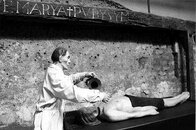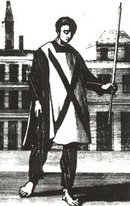Beau is his brother. Lloyd Bridges (Mike Nelson of Sea Hunt) was his father.I don't know about the ring, but when Jeff Bridges was here filming "Against All Odds," he stayed at the Sol Caribe (now the Park Royal). His father, Beau Bridges...
You are using an out of date browser. It may not display this or other websites correctly.
You should upgrade or use an alternative browser.
You should upgrade or use an alternative browser.
The pirates of Cozumel
- Thread starter El Graduado
- Start date
Please register or login
Welcome to ScubaBoard, the world's largest scuba diving community. Registration is not required to read the forums, but we encourage you to join. Joining has its benefits and enables you to participate in the discussions.
Benefits of registering include
- Ability to post and comment on topics and discussions.
- A Free photo gallery to share your dive photos with the world.
- You can make this box go away
OP
El Graduado
Contributor
- Messages
- 833
- Reaction score
- 1,666
Mea culpa! You are so right. I am getting sloppy and forgetful in my old age.Beau is his brother. Lloyd Bridges (Mike Nelson of Sea Hunt) was his father.
---------- Post added November 27th, 2014 at 12:58 PM ----------
El Graduado,
Have you attempted to research any of the sources of information used by the Texas State Historical Association?https://www.tshaonline.org/handbook/online/articles/fla12
I read the blurb the TSHA has online, and although it glosses over and simplifies many of the earlier facts about the Laffite brothers, it is basically correct. That is, until the last paragraph: Finally, with nothing to hope for from Spain and confronted with the American government's determination to end the Galveston establishment, the Laffites decided the game was up. Laffite abandoned Galveston early in May 1820 and sailed to Isla Mujeres, off the coast of Yucatán. There he continued his illegal activities until around 1825, when, mortally ill, he went to the mainland to die. Although his brother was the leader in all their affairs, Jean Laffite, more colorful than his older brother, has become the center of many romantic tales.
This last paragraph seems to be a copy error or some kind of misunderstanding on the part of the articles author. As I said before, most of these kinds of statements about the Laffite brothers are based on second hand reports, and the bibliography at the end of the article supports this assertion. The last years of Jean Lafitte are still unclear. Jean was not aboard the Nancy Eleanor with Pierre when Pierre and Lucy Allen left Charleston for Isla Mujeres in 1821, nor was Jean with his brother Pierre when Pierre fought with Miguel Molas later that year. There are newspaper articles (such as the one that appeared in the Gaceta de Colombia on April 20, 1823) that describe Jeans death on February 5, 1823 aboard the General Santandar, a ship he was using as a privateer with Colombian letters of marque. However, the article was simply reporting the naval encounter involving Jean's ship General Santandar and two Spanish vessels and there was no other proof offered to substantiate the articles claim that Jean died during the battle. Then, there is the COPY of a supposed lost journal of Jean Laffite. In the hand written facsimile, it is written that he faked his death, changed his name, and later died in the US. Whatever the truth is, one thing is for sure; Jean Lafitte is not buried in Dzilam.
As an aside, I am always amazed at how small the world is. One of my very good friends is Omer Claiborne, the brother of Liz Claiborne and a direct descendant of the Governor William C. C. Claiborne who drove the Lafittes from Barataria. Omer also once owned a bar in New Orleans that was the very same small building that Jean Laffite owned and used as his blacksmith shop and fencing operation in New Orleans.
OP
El Graduado
Contributor
- Messages
- 833
- Reaction score
- 1,666
By all means please do!!!
Although the myth that Cozumel was once the home base of many famous buccaneers is untrue, a few minor pirates did, in fact, briefly visit Cozumel during the 16th and 17th centuries. One such visitor was Pierre Sanfroy, who is often reported to have been a blood-thirsty pirate captain who used San Miguel’s church as his base in the 1570s. The truth is he was only a 27-year-old crewmember aboard the Chuetot expedition that spent 22 days on Cozumel in 1571. The story of this expedition is well documented in over 300 pages of court testimony taken between 1572 and 1574 during trials that took place in Merida and Mexico City.
The real story about Pierre Sanfroy begins on May 19, 1570, when a group of 40 young French Huguenots and lapsed Catholics banded together and set sail from La Rochelle, France in the French-flagged vessel L’Espérance, on an expedition they hoped would make them rich. The men aboard the ship were:
Pierre Chuetot, Ship’s Captain, a Catholic from Rouen
Nicolas de Siles, a Huguenot, and Master of the ship
Bouvier, the first mate
Martin Cornu, the ship’s barber-surgeon, age 24
Etienne Gilbert, pilot
Roger Grifel, merchant
Pierre Sanfroy, crewmember, age 27
Guillaume de Siles, crewmember, age 19
Guillaume Cocrel, crewmember, age 19
Guillaume Poitiers, crewmember
Robin Poitiers, crewmember
Guillaume Moutier, crewmember
Jaques Mortier, crewmember, age 27
Jean de Luayzell, crewmember
Mairiac, crewmember
Isaac Dorven, crewmember
Claude Ivilin, crewmember
Jean Hoscorno, crewmember
Robert Hoscorno, crewmember
Broutouneau, crewmember
“La Pombrea,” crewmember and ex-fraile,
“El Gitano,” crewmember
Marco Vilu, crewmember
Plus 15 more crewmembers and 2 cabin boys, for a total of 40 souls aboard
They first headed to Honfleur, France, then south to the Canary Islands where they took on water and food stores. From there they sailed south to Cape Verde Island, where they purchased cow hides. Near Madeira they captured a small Portuguese galeota, killing her crew and taking the small vessel along with them. From Madeira they sailed to Sierra Leone (on the coast of Africa) where they purchased ivory, which they planned to sell along with the hides in the Dominican Republic. Heading back north, the two vessels sailed to Guinea to acquire a few black slaves to add to the cargo. When they got ready to leave, a couple of the crew decided quit the voyage and stay in Guinea. This turned out to be a good decision on their part, because soon after the L’Esperance and the galeota left port, they were chased into a storm by the Portuguese Navy where the larger of the two vessels sank. Thirty of Chuetot’s crew managed to survive by shifting over to the small galeota and under these cramped circumstances sailed onward to Margarita Island, off the coast of Venezuela. There they captured a caravel owned by Melchior de Rivas with fourteen or fifteen people aboard, including two women, a sick Franciscan fraile, a lay cleric, and the ship’s Genovese pilot, Bernardo de Burdeos. The pirates’ next stop was Nombre de Dios, Panama, where the band captured a small Cuban vessel loaded with wine and owned by a Sr. Parada. They took the wine aboard and then killed the captured ship’s crew as well as the captives they had taken earlier, save Bernardo, the pilot. Shortly after, the Frenchmen captured another Spanish merchant ship, loaded with fine ceramics, hardware, linen, tiles, and religious books.
Chuetot’s band then sailed to Cozumel, where they captured another ship anchored off San Miguel de Xamancab. It was owned by Hernando Díaz and Gaspar de Chinchilla of Puerto Caballos, Honduras and under the command of Cristóbal de Hernández. T he ship had recently left Trujillo, Honduras with a load of merchandise to Rio Lagartos. After unloading at Rio Lagartos, it had come to Cozumel and taken aboard 4,000 cotton mantas, 200 arrobas of beeswax, 200 botijas of honey, and a few other commodities including lard. Opting not to land on the island, the Frenchmen took Hernández’ ship along with them and sailed north to Boca de Conil, the opening to the bay between Holbox and the mainland, where they again took a prize; the Nuestra Señoria del Rosario, owned by Pedro de la Mazuca, who was unfortunate enough to be aboard at the time. Vicente Estevez, the pilot of the Nuestra Señoria del Rosario, was also captured and forced to guide Chuetot’s ship through the reefs and flats of northern Yucatan. Mazuca was later to report how the French corsairs cut off his pilot’s leg with an ax for sport, before stabbing Mazuca himself four times in the arm.
The pirates transferred all their booty from the ship they had captured in Cozumel to Nuestra Señoria del Rosario, and since the ship they had taken in Cozumel was old and in bad shape, they burned her and let her sink. The Frenchmen then rounded the north coast of Yucatan and landed at Sisal on the western shore of the peninsula. From there, they marched inland to Hunucmá, Yucatan (a small settlement 5 miles south east of Sisal), where they robbed the village, desecrated the church, and took two caciques as prisoner. With the priest’s robes and altar cloths they had taken from the church, one of the crewmembers fashioned caps, underwear, and stockings.
News of this raid reached the government in Merida and a 40-man posse was marshaled to quick-march to Hunucmá and capture the pirates. Arriving to find the culprits already gone, the posse marched on to Sisal, but got there just in time to see the last of the pirates boarding their two ships as they hurled insults at the Spaniards ashore. One of the survivors of the pirate raid at Sisal told Francisco Tamayo, the captain of the posse, that he had overheard the Frenchmen say they were going to Telchac to ransom their two captive caciques, so Tamayo sent word to Campeche to send a ship to try to head them off.
Meanwhile, the Frenchmen sailed back eastward to Dzilam, where the two captive caciques managed to escape. From Dzilam, the pirates sailed to the village of Ecab and proceeded to sack the town and church. At Ecab, the crewman known as “El Gitano” burned the parsonage and the church’s books and then the rest of the crew defiled the church. Chuetot himself drew graffiti on the interior walls of the church, graffiti reported later by Rodrigo de Tapia, to consist of “…entre otras cosas- un rótulo en castellano que decía que el rey de Castilla no valía nada, y que ellos bastaban solos a darle guerra; y que también pintaron navíos y hombres y mujeres que se abrazaban y besaban y otras suciedades y naturas de hombres.” (“…among other things, a sign in Spanish that said the King of Castile was worthless and they were only good for making war; and that they also painted ships and men and women that were embracing and kissing and other dirty things and penises.”)
Other witnesses reported seeing graffiti of “… sailing vessels…and the Virgin Marry together with a seven-headed monster.” Alonso de Villanueva testified that “among other things, they wrote ‘Viva el Rey de Francia!’ on the walls of the church.”
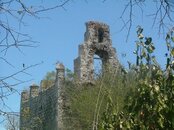
Above: The church at Ecab (Boca Iglesia) today.
When news of the pirates’ raid reached Valladolid, Juan Gutiérrez Coronel, the town’s Alcalde, organized another posse to try and overtake them. Arriving at Ecab, the posse confronted the pirates, but only managed to kill a few before the pirate band split into two groups: One group boarding the Nuestra Señoria del Rosario and sailing back to France; the other group of twenty escaping in the small Galeota and sailing down the coast. This second group eventually reached Polé (Xcaret) and robbed the church there and made wicks for their matchlock guns from the altar cloth. From Polé, the pirate band crossed the channel to Cozumel, where the islanders at first gave them a friendly reception. Soon, however, the Frenchmen demanded more than the islanders were willing to give, and they began harassing the Cozumeleños, calling for more food and drink, whipping the ones who refused their requests and generally running amok. The band took up residence in the church at San Miguel de Xamancab for the next 22 days, drawing graffiti on the walls, urinating and defecating inside the building, and making the altar at times a bed and at other times a table where they took their meals. In front of the church, the Frenchmen built a set of stocks, where they would lock-up any islander who gave them problems. Pedro de la Mazuca later testified “…en San Miguel, en Cozumel, escribían letras por las paredes y pintaban personajes, que no debiera ser cosa buena; sobre un altar tenían trapos viejos y andrajos.” (“…in San Miguel, in Cozumel, they wrote letters on the walls and painted caricatures, which was not a good thing; over an altar they had old clothes and rags.”)
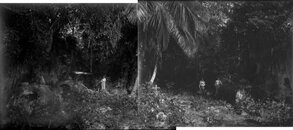
Above: The roofless church at Xamancab (San Miguel) in 1913. Photo by Jesse Nussbaum.
But the pirates’ reign on Cozumel came to an end when their prisoner, Pedro de la Mazuca, escaped and sailed the galeota back to Polé, where he reported the events of Cozumel to a third Spanish posse that had just arrived from Valladolid. The posse then crossed over the channel and surprised the French sentries, who had been stationed on the beach. The sentries abandoned their posts and ran to the church, alerting their comrades. Sneaking out the back under the cover of nightfall, the French fled to Santa Maria de Oycib (Cedral), where they barricaded themselves in a corral and awaited the Spanish to attack. In the morning, after a brief fire-fight, the pirates ran out of gunpowder and surrendered. The Spanish posse had managed to kill eight of the Frenchmen and wound two more (including Captain Chueltot), who the islanders carried back to San Miguel de Xamancab and summarily hung. The rest were taken by ship to Telchac, then overland to Merida.
In Merida, the ten remaining Frenchmen were tried and found guilty of piracy. Pilot Etienne Gilbert and crewmember Isaac Dorven were hung on July 17, 1571. Jean Hoscorno and Claude Ivilin were hung the following day. Pierre Sanfroy, Guillaume de Siles, Guillame Cocrel, Martin Cornu, Jacques Mortier, and Guillaume Potier were made slaves in the service of various Merida households.
But they did not remain slaves for very long. On September 13, 1571, Pierre Sanfroy and his five crewmates were ordered to stand before a new trial at the offices of the Holy Inquisition in Mexico City. Between March and August, 1572, the six Frenchmen were sent one at a time to Mexico City to be tried not for being pirates, but instead, for being Lutheran heretics. Guillaume Potier managed to escape en route to Mexico City and was never heard from again. He was later judged guilty in abstencia, excommunicated, and burned in effigy.
On June 7, 1572, Sanfroy, Siles, Cornu, Mortier, and Cocrel were accused of the crimes of “being Lutheran, for uttering injurious words against the Pope, for uttering injurious words against the king of Spain, for eating meat on Friday, for reading aloud the psalm of David, for robbing the church at Hunucmá, for mocking the holy Mass and the sacraments, for profaning churches, and for robbing villages in Yucatan.” Jaques Mortier never lived to see his trial. He died in detention in Mexico City on December 24, 1572.
Testifying against the French pirates were the batab of San Miguel Xamancab (Francisco Pat) and the two batabs of Santa María de Oycib (Pedro Pot y Juan Mah), all of Cozumel. Pablo Pat of Ecab also testified for the prosecution, as did Juan Ye, Juan Pat, and Diego Niho of Polé. The captured ship-owner, Pedro de la Mazuca, testified as well, along with Alonso de Villanueva and Rodrigo de Tapia.
On the morning of December 11, 1573, Sanfroy was ordered to be interrogated under torture on el potro (the rack) and submitted to “toca hechar agua” (waterboarding) “in caput propio y alienum,” (until he confesses to his own crimes and those of others he witnessed). He was taken from the court room and led to the torture chamber where he was stripped down to his underwear. For four hours he was tortured on the rack and water-boarded until 12:45, when he confessed to eating meat on Fridays and of sympathizing with the Lutherans. At that, he was untied and allowed to dress.
Pierre Sanfroy was a 27-year-old French seaman from Saint-Vigor, on the Coast of Normandy. He was described as “white, good-looking, with a red face and a thick, reddish-blonde beard and a scar close to his left eye, just above his beard.” Pierre’s father was a French gentleman, Charles Sanfroy, who was a Catholic and had Pierre baptized as a child and had raised him as Catholic as well.
Pierre Sanfroy’s first experience in warfare was when he had fought for nine months with the Catholic captain Forian against the Protestants in France. Later, he fought against the Anglicans at Le Havre. Still later, he fought against the Calvinists under Captain Villers, before joining Captain Pierre Chuetot on his expedition. When he was incarcerated in Merida, Sanfroy had only 9 reales on him, which were confiscated and applied to the cost of his prison meals.
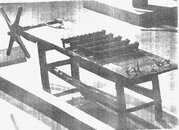
Guillaume de Siles, Sanfroy’s 20-year-old crewmate, was sentenced to 200 lashes and 4 years rowing. Guillaume Cocrel, a 19-year-old crewmember, was sentenced to 200 lashes and 6 years rowing. Martin Cornu, age 25, was garroted, his body burned, and his ashes strewn in the gutter. Guillaume Potier, who had escaped while being taken to Mexico City, was judged guilty in abstencia, excommunicated and burned in effigy.
On January 12, 1574, Sanfroy received his final sentencing: he was to be paraded through the streets of Mexico City while given 200 lashes de vehementi. After that, he was to serve as a galley slave, rowing the king’s ships without pay for six years.
On the 28 of February, 1574, Sanfroy was removed from his cell and taken to the courtroom to make a formal statement repenting his sins. The next day, he was dressed in a yellow sambenito, or penitent’s robe with the cross of Saint Andrew on the front, given a lit cirio penitencial, or green candle to carry, and paraded through the city to the steps of the main church. There he was stripped from the waist up and given his 200 hard lashes. A few days later he was shipped off to begin his sentence as a galley salve, and was never heard from again.
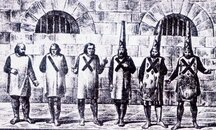
Above: The robes of the sambenito, ranging from the robe assigned to the least offensive heretic, (on the left) to the most offensive (on the right). Sanfroy was forced to wear the style third from the left.
Above: A penitent carrying a lit cirio penitencial, or green candle.
sharky60
Contributor
whatever. just because YOU can't find any evidence that someone was here 300 years ago, doesn't make it so.
OP
El Graduado
Contributor
- Messages
- 833
- Reaction score
- 1,666
whatever. just because YOU can't find any evidence that someone was here 300 years ago, doesn't make it so.
OK, Sharky. YOU tell ME where you get your documents showing there were buccaneers using Cozumel as their headquarters. Wikipedia and dive shop websites don't count.
If I used your logic, I'd be forced to say that just because I can't find any evidence that definitively disproves the idea that pink, francophone giraffes inhabited Cozumel in the 1700s, it doesn't mean they didn't.
Why do you want to cling to these old fairy tales so tightly? I find that real historical events are far more interesting than make-believe.
Ugg. I hope not. If there is one thing I hate, its francophone giraffes. In any color really....
DjDiverDan
Contributor
Jeff Bridges' father, and the star of Sea Hunt, was Lloyd Bridges. Beau is Jeff's brother.
OP
El Graduado
Contributor
- Messages
- 833
- Reaction score
- 1,666
Jeff Bridges' father, and the star of Sea Hunt, was Lloyd Bridges. Beau is Jeff's brother.
Please see my earlier apology in this thread for my absent mindedness and mixing up the two names. I have no excuse other than...
What was it we were we talking about again?
Pelagicsal
Dedicated Dive Bum
- Messages
- 4,470
- Reaction score
- 766
- # of dives
- 2500 - 4999
Still enjoying the info and the stories, Ric. Thanks so much for taking the time! Hope your Thanksgiving was marvelous.
Wasn't there a story about the one ring to rule them all being lost on Cozumel? Is that one true?
My wife flipped her wedding ring into the ocean back in February while trying to take it off for "safe keeping" on the dive boat. Does that count?
---------- Post added November 30th, 2014 at 03:12 AM ----------
Although the myth that Cozumel was once the home base of many famous buccaneers is untrue, a few minor pirates did, in fact, briefly visit Cozumel [snip fascinating history lesson]
Thank you for posting that. That was the most interesting thing I read all week.
Similar threads
- Replies
- 9
- Views
- 1,055
- Replies
- 10
- Views
- 1,388



